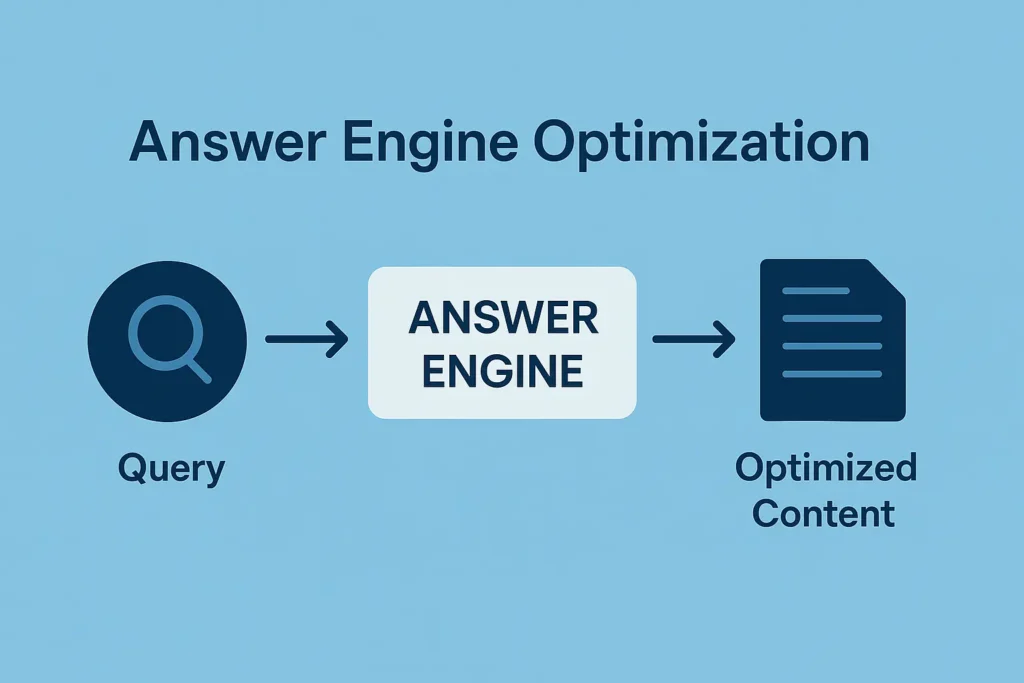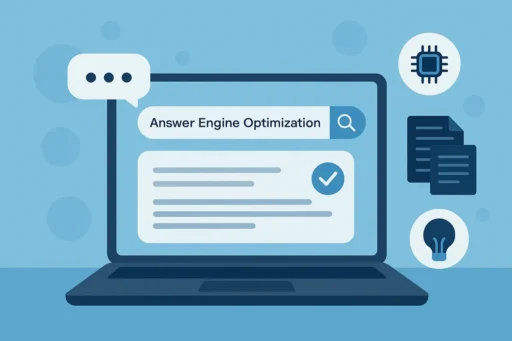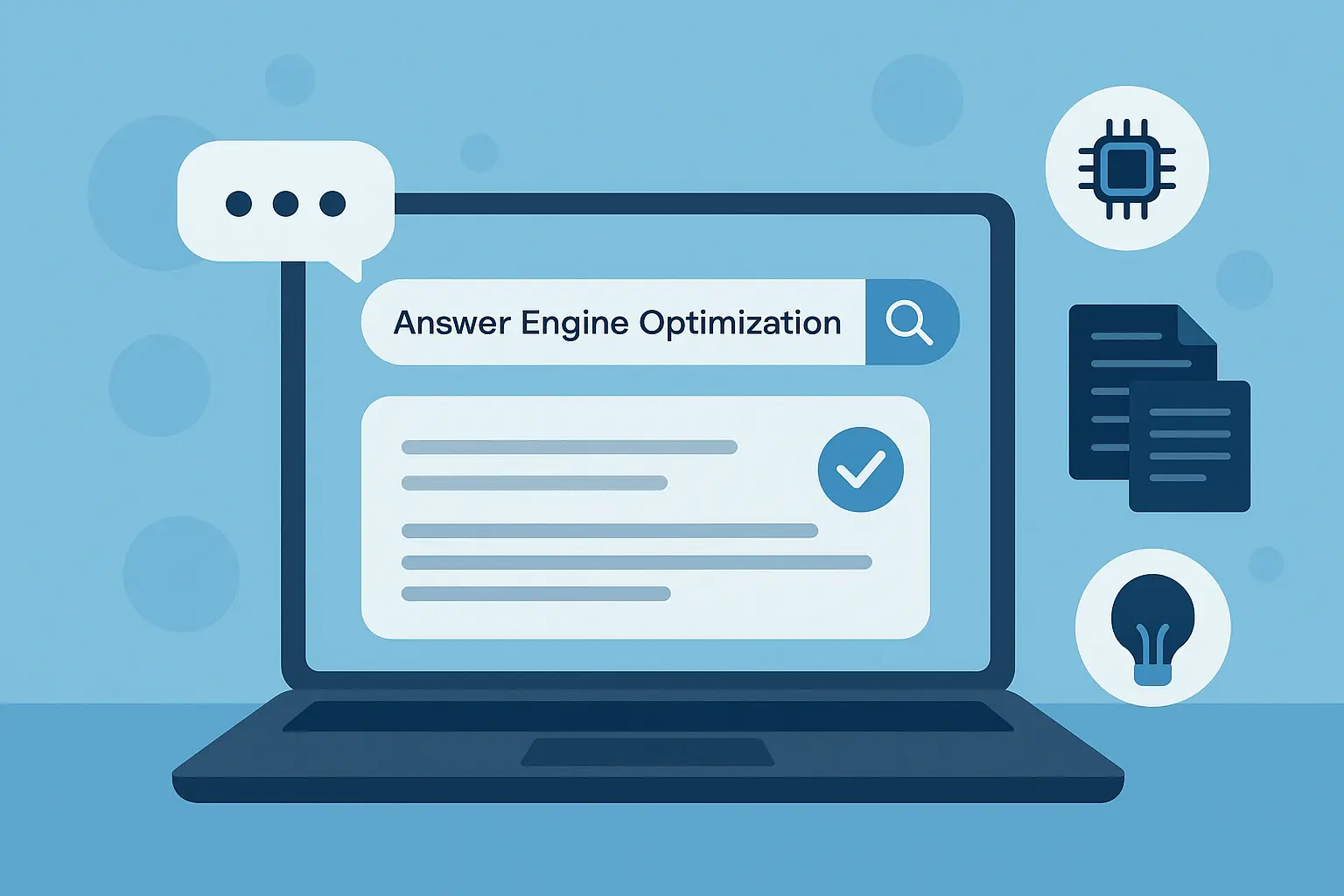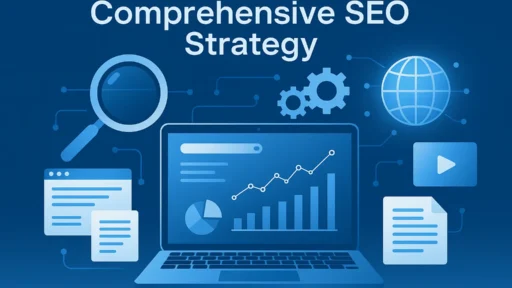AI is changing how people find and trust information. Instead of clicking ten blue links, users increasingly get direct answers from Google’s AI Overviews, Microsoft’s Copilot (Bing), ChatGPT, and Perplexity—often with citations. “Answer Engine Optimization” (AEO) is the discipline of earning visibility and citations inside those answers. It builds on classic SEO, but adapts content, structure, and evidence for AI systems that summarize and attribute.
What is Answer Engine Optimization (AEO)?
AEO is the practice of shaping your site and brand so AI systems can confidently extract, summarize, and cite your content as the answer. Think question-led content, concise takeaways, rigorous sourcing, and machine-readable structure—so that answer engines prefer your page when composing their response.
Why AEO Matters Now
- Mass Adoption: Google reports AI Overviews are used by 1.5B+ people and are integrated with core ranking systems, surfacing links that support the generated answer.
- Growing Coverage: Independent tracking shows AI Overviews appear in roughly 11–18% of queries (varies by dataset and market).
- Traffic Impact: Studies indicate impressions rise but click-through declines ~30% when AIO shows; users click fewer organic links, especially on pages with summaries. (Treat these as directional, not absolute.)
How Today’s Answer Engines Work (and What They Reward)

Google: AI Overviews + AI Mode
Google uses a customized Gemini model alongside its Search ranking systems and Knowledge Graph to generate summaries with supporting links. AI Mode can run a “query fan-out”—issuing multiple searches across subtopics—then synthesizes results with links to explore further. Practically, that means Google is looking for concise, corroborated facts from authoritative sources it already ranks well.
Implication: Be the best corroboratable source: clear answers, consistent entities, and strong external validation.
Microsoft: Copilot (Bing)
Copilot “grounds” answers in the Bing search index, sending short, generated queries to fetch current web results, then adds linked citations in the response. For enterprises, Copilot Studio lets agents ingest websites and other knowledge sources.
Implication: If Bing can find, parse, and trust your page, Copilot can cite it—so ensure crawlability, clarity, and source credibility.
Perplexity
Perplexity positions itself as a real-time answer engine that always shows citations and lets publishers/creators build “Pages” (long-form, public write-ups). It’s rapidly evolving and widely used in research contexts—but has also faced scrutiny about web-scraping and attribution practices. Optimize for both the opportunity (citations) and the risk (accuracy, publisher policy).
Implication: Provide quotable, well-sourced passages on canonical URLs that Perplexity can reference.
ChatGPT (OpenAI)
ChatGPT may browse the live web (depending on mode) and OpenAI operates crawlers like GPTBot and other user agents. You can allow or block these via robots.txt. If you want ChatGPT to find and cite your content during browsing, make sure you’re crawlable and your pages summarize key facts clearly.
The AEO Playbook: How to Earn Citations Across AI Overviews, Copilot, ChatGPT & Perplexity
1) Write Answer-Ready Content
- Lead with a one-paragraph summary that directly answers the primary question—then expand.
- Use question-based H2/H3s (“How does X work?”, “Is Y better than Z?”), scannable lists, and evidence-backed claims.
- Align with Google’s guidance for helpful, reliable, people-first content and E-E-A-T principles.
2) Add Schema Markup So Machines Understand Your Page
Implement FAQPage, HowTo, Product, Organization, and Article schema in JSON-LD where appropriate. This improves understanding and eligibility for rich features that AIs also consult.
3) Strengthen Entity Signals & Attribution
- Make your brand and authors easy to verify: consistent Organization/Person pages, bylines, and links to authoritative profiles.
- Help engines tie facts together by aligning with the Knowledge Graph (clear entity names, unambiguous copy, and structured data).
4) Publish Original Data & First-Hand Expertise
- Original research, benchmarks, and case studies are highly cite-worthy.
- Demonstrate experience and trust with transparent methods and external references—what Google calls “people-first content.”
5) Be Crawlable To Answer Engines (or Opt Out Intentionally)
Ensure no accidental blocking of Bing, Google, or OpenAI crawlers. If you prefer not to be used in training/browsing, you can disallow GPTBot or other agents in robots.txt.
Example:
User-agent: GPTBot
Disallow: /
Or allow explicitly:
User-agent: GPTBot
Allow: /
(Confirm current user agents in OpenAI’s crawler documentation.)
6) Optimize For Longer, Conversational Queries
AI Overviews and chat answers trigger disproportionately on longer, complex queries; coverage has expanded most in these areas. Create content that answers composite, multi-step questions with clear sub-sections and follow-ups.
7) Make Your Page Quotable
- Include concise definitions, step-by-step “How it works”, pros/cons tables, and mini-checklists.
- Use precise numbers and citations so answer engines can lift a line and attach a source.
8) Maintain Freshness
Copilot grounds in current web sources; Google’s AI Mode fans out to real-time results; Perplexity actively crawls. Keep date stamps, update sections regularly, and provide change logs where practical.
AEO Tactics Mapped to Each Engine
Google AI Overviews / AI Mode
- Content shape: Clear intro answer, entity-rich copy, strong citations/outbound links.
- Technical: Comprehensive schema; strong internal linking to supporting pages; canonical URLs.
- Why it works: Google corroborates AI answers with high-quality web results and Knowledge Graph facts; query fan-out benefits pages that cover a topic comprehensively with sub-answers.
Bing Copilot
- Content shape: Well-structured answers with verifiable sources; include stats and definitions that are easy to quote.
- Technical: Ensure Bingbot crawlability, sitemaps, and timely updates; Copilot adds linked citations grounded in Bing results.
Perplexity
- Content shape: Highly factual, citation-rich sections; TL;DR summaries; tables.
- Platform lever: Consider repackaging research into Perplexity Pages to seed canonical answers (with care for duplication strategy).
ChatGPT (with browsing)
- Content shape: Put essential facts near the top; include clear headings and unique data that a browsing agent can quote.
- Technical: Allow relevant OpenAI user agents if you want to be discoverable; keep pages fast and readable.
Industry Data: What We’re Seeing in 2025
- Coverage: AI Overviews appear on ~11–18% of queries depending on the study/timeframe. Coverage surged for certain categories during core updates.
- Behavior shift: Longer, conversational queries are up; Google triggers AIOs far more for these.
- Clicks vs. Impressions: BrightEdge reports impressions +49% YoY but CTR –30% on AIO pages; Pew finds users are less likely to click when an AI summary appears. Expect higher “zero-click” behavior and focus on being cited.
Takeaway: In AEO, citation share matters as much as rank position.
Example: Turn a Topic Into an “Answerable” Page
H2: What is carbon-negative concrete?
Answer (2–3 sentences): Define in plain English; cite peer-reviewed or standards bodies.
H3: How it works (step-by-step)
H3: Pros & limitations (table)
H3: Costs & availability (bulleted facts, sources)
H3: Key standards & certifications (linked list)
This format makes it easy for AI Overviews / Copilot to lift a precise definition, a step, or a stat—and cite you.
Measurement: How to Track AEO Performance
- Google Search Console
- Watch page-level impressions vs. clicks for target queries. If impressions rise while CTR falls, you may be appearing under an AIO. Your goal: get cited in that AIO. (This pattern aligns with industry findings.)
- Bing Webmaster Tools
- Monitor indexation and query coverage; sanity-check how your pages appear in Bing, since Copilot grounds on Bing results.
- Answer-engine spot check
- Test priority questions in Google (web + AI Mode), Bing Copilot, ChatGPT (browsing), and Perplexity.
- Log whether you’re cited and which snippet was extracted. Perplexity’s help docs confirm every answer includes citations you can click.
- Content QA
- Validate claims and references—AI systems scrutinize corroboration. (Perplexity and others cite sources, but reliability varies; news investigations have flagged accuracy and attribution issues—another reason to make your content unambiguous and well-sourced.)
AEO in 10 Practical Moves (Do These Next)
- Map question clusters for each product/topic (primary “what/why/how/cost” + adjacent comparisons).
- Create answer-first pages with concise TL;DRs and well-labeled sub-answers. Align to Google’s people-first guidance.
- Add FAQPage/HowTo/Product schema where relevant.
- Add author bios with credentials and outbound proofs (publications, patents, standards groups).
- Publish original data (benchmarks, surveys, field tests) and cite third-party standards or studies.
- Cite your sources liberally—answer engines reward verifiability.
- Ensure Bing/Google/OpenAI crawlers can access your content (unless you opt out).
- Build entity clarity: consistent names, logos, and IDs (Organization schema; link to authoritative profiles).
- Refresh quarterly: update stats, add new FAQs, and timestamp updates (helps Copilot/AI Mode retrieve fresh facts).
- Track citation wins weekly across engines; iterate content where you’re close but not cited.
Key Caveats
- AIO presence is dynamic by query, market, and time; treat coverage and CTR deltas as directional.
- Quality and safety filters are strict (especially for YMYL topics). Your claims must be well-supported and traceable.
- Grounding ≠ endorsement. Copilot/Perplexity cite sources, but inaccuracies still occur. Your best defense is rigorous, transparent content.
Final Word
Answer Engine Optimization isn’t a replacement for SEO—it’s the next layer. If you make content that’s answerable, attributable, and structured, you can earn visibility in AI Overviews, Bing Copilot, ChatGPT browsing results, and Perplexity citations—all while strengthening traditional rankings. Start with your highest-value questions, add structure and sources, and measure citations like you measure rankings.





